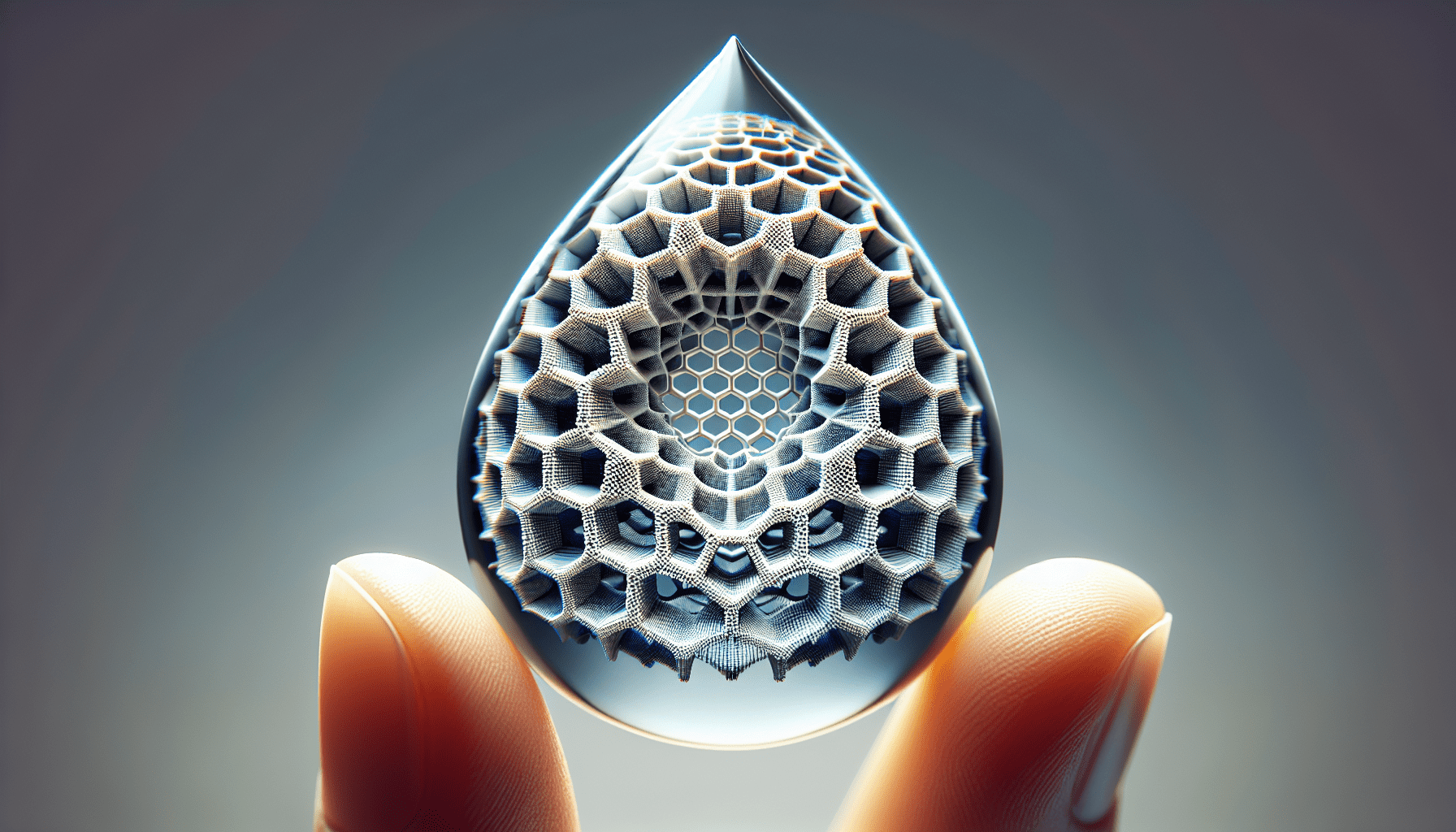AOSEED 3D Printer for Kids, Beginner 3D Printer with 8 PLA Filament Set, Huge Toy Library & Modify, Wi-Fi & App Control, Create STEM Toys, High Precision, W/ 15+ Mini 3D Design Module, X-Maker Joy
$254.99 (as of March 8, 2025 20:51 GMT +00:00 - More infoProduct prices and availability are accurate as of the date/time indicated and are subject to change. Any price and availability information displayed on [relevant Amazon Site(s), as applicable] at the time of purchase will apply to the purchase of this product.)Ever wondered how we can effectively remove the stubborn “forever chemicals” from our water supplies? These persistent agents are a global concern, but a groundbreaking research study from the University of Bath may have just offered a promising solution using 3D printed ceramic lattices. Let’s delve into this fascinating topic in more detail, as we unpack how this innovation works and why it matters.

$30 off $400+ Anycubic Products with code AC30OFF
Understanding Forever Chemicals
What Are Forever Chemicals?
Forever chemicals, also known as per- and polyfluoroalkyl substances (PFAS), are a group of man-made materials that have become ubiquitous in our environment due to their extensive use in various consumer products. These chemicals are found in water-repellent fabrics, non-stick pans, firefighting foams, and even certain paints. They are incredibly resistant to degradation, taking over a thousand years to break down, hence the name “forever chemicals.”
The Perils of PFAS
PFAS have been linked to numerous health issues, including reproductive, developmental, and cardiovascular problems. Their durability makes them incredibly challenging to remove from the environment, leading to widespread contamination of water supplies. This persistent presence poses a threat both to human health and to ecosystems around the world.
The Innovation from the University of Bath
The Birth of the Idea
Researchers at the University of Bath have been working on a novel method to tackle the problem of PFAS contamination in water. They have developed 3D printed ceramic lattices, termed “monoliths,” that can efficiently capture and remove these hazardous chemicals from water supplies. According to Dr. Liana Zoumpouli, a Research Associate at the university’s Department of Chemical Engineering, this method not only shows impressive efficacy but is also energy-efficient.
How Do These Monoliths Work?
The 3D printed monoliths are made from a special ink infused with ceramic indium oxide, a material known for bonding with PFAS. The monoliths are created using an extrusion 3D printing process, resulting in a cylindrical lattice structure. This structure significantly increases the surface area of the monoliths, allowing more PFAS to adhere as water flows through them.
Post-printing, the lattices are dried at room temperature for 12 hours and then subjected to a sintering process in a tubular furnace at 500 °C for 10 hours. This preparation enhances the chemical bonding properties of the material, making the monoliths highly effective at trapping PFAS.
Impressive Results
In tests, these monoliths have successfully removed at least 75% of PFAS from contaminated water within just three hours. This duration is compatible with existing water treatment plans in the UK and beyond, making it a practical addition to current systems. Moreover, the research shows that these monoliths actually become more efficient over time. After each use, they undergo a high-temperature thermal regeneration treatment, which enhances their performance in subsequent cycles.
| Parameter | Value |
|---|---|
| Average PFAS Removal | 75% |
| Treatment Time | 3 hours |
| Sintering Temperature | 500 °C |
| Sintering Time | 10 hours |
| Regeneration Process | Thermal |

Buy Photon Mono M5 Get Free 1KG Resin
The Broader Implications
Scalability and Simplicity
One of the most exciting aspects of this technology is its scalability. Dr. Zoumpouli notes that 3D printing allows for the creation of objects with high surface areas without overly complex methods. Once printed and prepared, these monoliths can simply be dropped into water reservoirs to start filtering out contaminants.
Potential for Policy Change
This innovation comes at a crucial time. Currently, the UK does not have stringent regulations for PFAS in drinking water, but guidelines exist and discussions about policy changes are ongoing. As the need for effective water treatment solutions becomes more pressing, technologies like this could be pivotal. Professor Davide Mattia, a co-author of the study, suggests that water companies may soon look to incorporate such systems into their treatment plans.
Future Developments
While the current results are promising, the research team is optimistic about further enhancements. They believe that with additional adjustments, these 3D printed monoliths could achieve even higher PFAS removal rates. This continued improvement will be critical as legislation surrounding these chemicals evolves and becomes more stringent.
The Science Behind It
The Role of Ceramic Indium Oxide
Ceramic indium oxide plays a crucial role in the efficacy of these monoliths. Its unique chemical properties allow it to bond with PFAS molecules, effectively removing them from water. This bonding occurs at a microscopic level, which is why increasing the surface area of the monoliths is so essential. More surface area means more points for PFAS molecules to adhere to, enhancing the overall capacity for chemical removal.
Thermal Regeneration
Thermal regeneration is another key aspect of this innovation. After each filtration cycle, the monoliths undergo a high-temperature treatment that rejuvenates their chemical bonding properties. This process ensures that the monoliths do not become ineffective over time, making them a sustainable solution for long-term use.
Comparative Efficiency
Compared to existing methods of PFAS removal such as activated carbon filters and reverse osmosis, the 3D printed monoliths offer several advantages. They are not only effective but also require less energy. Current methods often involve complicated processes and energy-intensive machinery, whereas dropping a monolith into a water tank is far simpler and more energy-efficient.
Real-World Applications
Water Treatment Plants
The obvious application of these monoliths is in water treatment plants. By integrating this technology into existing systems, it’s possible to significantly reduce the levels of PFAS in drinking water supplies. The ease of use and scalability make it an attractive option for municipalities looking to upgrade their water treatment facilities.
Emergency Response
In areas affected by sudden water contamination, these monoliths could serve as a quick and efficient solution. Their portability and ease of deployment would allow emergency response teams to address PFAS contamination effectively, providing safe drinking water faster than traditional methods.
Industrial Applications
Industries that produce PFAS as a byproduct can also benefit from this technology. Instead of allowing these chemicals to enter the water system, industries can treat their wastewater on-site using 3D printed monoliths, thereby reducing environmental contamination and complying with regulatory standards.
The Future of Water Filtration
Innovations Ahead
While this breakthrough is already a giant leap, the potential for future innovations is vast. The research team at the University of Bath is continually working to refine the technology, aiming to increase the efficiency and longevity of the monoliths. This continuous improvement cycle ensures that the method will remain relevant and highly effective as new challenges arise.
Legislative Impact
As legislation around PFAS and other hazardous chemicals becomes more robust, the demand for effective filtration methods will only increase. Technologies like the 3D printed ceramic monoliths are well-positioned to meet this demand, providing a scalable and reliable solution that can adapt to changing regulations.
| Aspect | Current Status | Future Potential |
|---|---|---|
| Removal Efficiency | 75% | Potential for higher rates |
| Treatment Time | 3 hours | Faster processing possible |
| Regulatory Compliance | Meets guidelines | Adaptable to future laws |
| Scalability | High | Extendable to larger systems |
Global Reach
The implications of this technology extend far beyond the UK. Countries around the world face similar challenges with PFAS contamination, and adopting this innovative method could have a global impact. The scalability and simplicity of the technology make it an ideal candidate for international deployment.
Collaboration and Development
The success of the 3D printed ceramic monoliths highlights the importance of collaboration between academic institutions and industry partners. By working together, it’s possible to take innovations from the lab to the real world more efficiently. This collaboration could also pave the way for further advancements in other areas of water treatment and environmental protection.
Conclusion
Removing forever chemicals from our water supplies is no small feat, but the 3D printed ceramic lattices developed by the University of Bath offer a promising solution. With their high efficiency, scalability, and potential for global application, these monoliths represent a significant step forward in water treatment technology.
As we continue to face the challenges posed by PFAS and other contaminants, innovations like these remind us of the power of human ingenuity. By embracing new technologies and fostering collaboration, we can make meaningful strides towards ensuring that our water supplies are safe and clean for future generations. So, the next time you think about the water you drink, consider the incredible science at work behind the scenes, transforming a seemingly simple resource into a cornerstone of public health.
$30 off $400+ Anycubic Products with code AC30OFF








